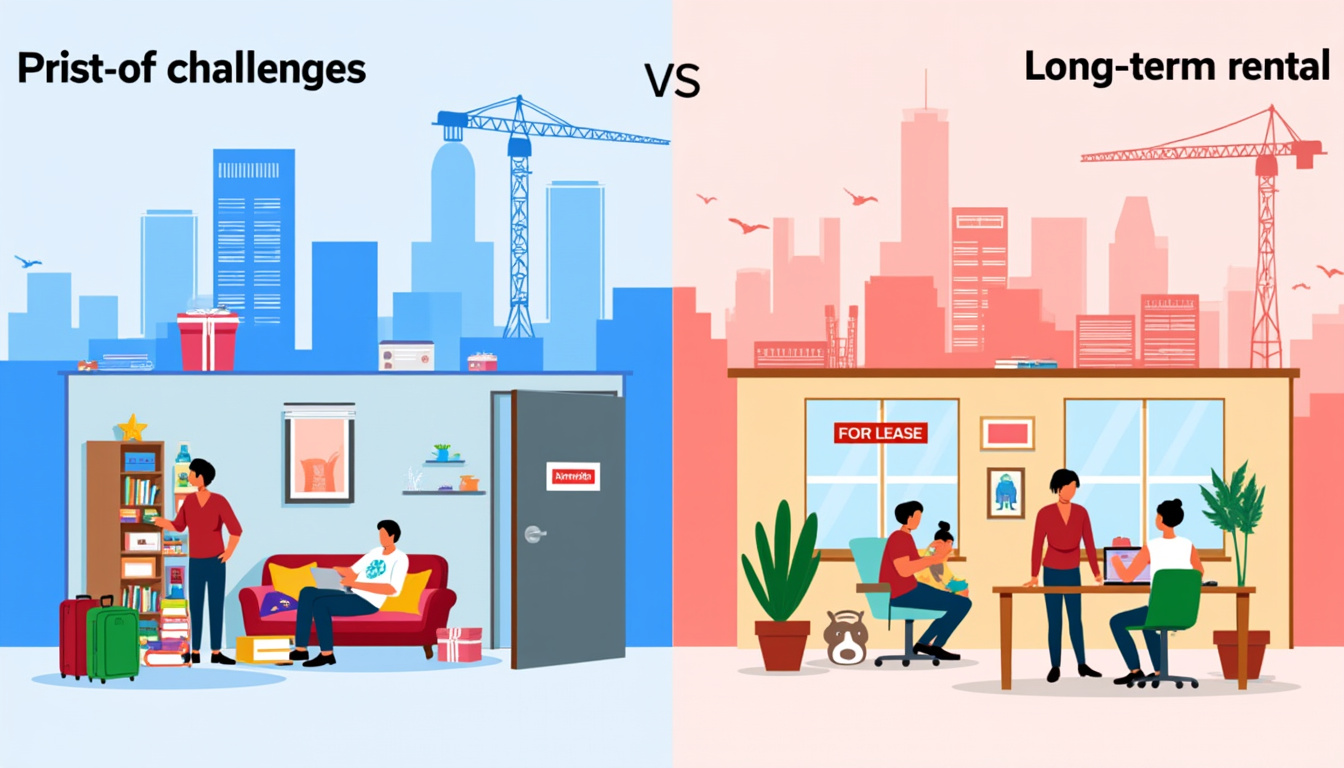New York City implemented a critical law in 2023, termed Local Law 18, with the aim of mitigating its severe housing crisis by regulating short-term rentals. The expectation set by lawmakers was that this crackdown on platforms like Airbnb would ultimately lead to reduced rent prices and increased availability of rental units for New Yorkers. However, a recent report highlights that despite these ambitious goals, the situation has not improved as anticipated. Instead, rental prices have soared, vacancies are now at historic lows, and the housing crunch in the Big Apple continues unabated.
Context of the Airbnb Ban and Its Intended Goals
Local Law 18 emerged out of a pressing need to address the overwhelming demand for affordable housing in New York City, where rents had become prohibitive for many inhabitants. The law was marketed as a dual-purpose measure aimed at both protecting residential housing from the encroachment of tourist rentals and enhancing neighborhood quality of life by reducing disruptive transient rentals. Legislators believed that driving out short-term rentals would favorably impact the long-term rental market, providing much-needed relief to a struggling housing sector.
The law effectively mandated a crackdown on short-term rentals, especially those listed on platforms like Airbnb, Vrbo, and Booking.com. Data extracted from the law indicated that, at its height, approximately 38,500 unauthorized Airbnb units were eliminated. In an effort to establish a tighter control over the rental landscape, the city began tightening restrictions, resulting in a drastic reduction of available short-term listings from nearly 4% of the market to merely 0.3%. These measures were aimed not only at returning properties to the long-term rental market but also at creating a more sustainable urban environment.
Once the law went into effect, immediate changes were noticeable. Residents reported a significant drop in noise complaints and disturbances associated with short-term rentals. From a community standpoint, this aspect of the ban can be considered a success. However, the core objective of making housing more affordable has not materialized as anticipated. Current statistics reveal a startling median rent of $4,700 a month in Manhattan, alongside a vacancy rate that has plunged to a meager 2.45%. These outcomes have prompted many to question whether the heavy-handed approach was misguided from the outset.
Impacts on Rent Prices and Market Dynamics
One of the most striking elements of the report is its indication that rents have actually increased in neighborhoods previously saturated with Airbnb rentals. Jonathan Miller, the CEO of appraisal firm Miller Samuel, pointed out that “the law doesn’t seem to have a material impact in making rents more affordable.” This assertion is echoed by Airbnb, which argues that removing short-term rentals did not lead to any significant positive changes in housing affordability.
Moreover, the dynamic surrounding demand and supply for housing apt in New York City is influenced by numerous factors, including fluctuating construction rates and overall economic conditions. Rents have seen a quarterly spike and municipalities that have engaged in similar types of bans, such as Irvine, California, experienced analogous trends. While initial quarters may show a slight easing of rental prices, a steady climb often follows as the market adapts to these restrictions.
Statistics suggest that hotel occupancy rates have surged following the implementation of the ban, further complicating the situation. As consumers transitioned to hotels, nightly rates escalated by 7% since the introduction of Local Law 18, reflecting an ongoing demand for temporary accommodations. This continued fragmentation of the rental market poses critical questions about the effectiveness of regulatory measures aimed at the short-term rental market.
Table: Comparison of Rental Prices and Vacancy Rates Pre- and Post-Local Law 18
| Year | Median Rent ($) | Vacancy Rate (%) | Short-Term Rentals (Units) |
|---|---|---|---|
| 2022 | 4,200 | 4.5 | 38,500 |
| 2023 | 4,700 | 2.45 | 3,000 |
Reactions from Stakeholders and Industry Analysts
The response from various stakeholders, including housing advocates, real estate professionals, and even Airbnb itself, has been notably critical of the law’s apparent shortcomings. Several analysts have emphasized that while the intention behind Local Law 18 is commendable, its execution has led to unintended consequences that have made affordability worse for the average New Yorker. The loss of short-term rental units hasn’t translated into an influx of long-term rental options.
Many argue that the law has stunted the potential for property owners to leverage short-term rentals to alleviate their own individual financial strains. These opportunities were crucial for many individuals, especially during events or periods of high demand, such as when tourists flood the city for occasions like the US Open or related events. With platforms like Sublet.com and Apartments.com not sufficing to meet the burgeoning demand for apartments, the average New Yorker finds themselves caught in an increasingly tight rental market.
This sentiment is echoed in a slew of media reports and statements from both Airbnb and its supporters, who point out that the ban has inadvertently compounded the affordability crisis rather than alleviating it. For instance, Airbnb’s director of public policy for North America has publicly criticized the law, emphasizing that removing these rental options has exacerbated the financial pressure facing renters and homeowners alike in New York.
Influence of Lobbying Efforts on New York’s Rental Market
In light of the ongoing tensions surrounding Local Law 18, Airbnb has initiated an aggressive lobbying blitz aimed at swaying public opinion and garnering support from lawmakers. The company’s investments in political campaigns, which have surpassed $3.6 million recently, are designed to galvanize candidates in favor of loosening restrictions surrounding short-term rentals. These efforts are particularly visible as the city prepares for major events that have historically attracted thousands of tourists.
Critics argue that these lobbying efforts could hinder the chances of enacting meaningful change around housing affordability. Institutional support for the law has been bolstered by groups such as the Hotel Trades Council, indicating a substantial divide in opinions across different stakeholders regarding the best way to address the housing crisis.
This conflict of interest presents a challenging battle for lawmakers. They must balance pressure from their constituents, who often face exorbitant rental prices, against the potential economic benefits that might be jeopardized by an influx of short-term rentals. Like hotels such as Marriott or Hilton, many players in the real estate industry defend the measures as essential for maintaining a sustainable and equitable housing market.
The Role of Tourist Demand in Shaping Housing Affordability
The intricate relationship between New York’s housing market and its status as a prime tourist destination cannot be overlooked. As housing prices continue to skyrocket, many argue that the influx of short-term rentals siphons much-needed inventory from the long-term market. The ban’s primary intention was to ensure that more units were available for New Yorkers, yet paradoxically, the demand for tourist accommodations is on the rise.
Hotel occupancy levels are witnesses to this phenomenon, reaching new heights even after the imposition of Local Law 18. In many respects, the availability of rental properties for tourists has increased the financial pressures on long-term renters, driving rents upwards in some neighborhoods that once had a higher density of Airbnb listings. This scenario creates a cycle wherein the very measures designed to protect housing affordability may unwittingly be intensifying the crisis.
A comprehensive review of the overall market dynamics indicates that decisions made by city officials can have far-reaching implications on housing affordability. For instance, neighborhoods that previously experienced high volumes of tourism may see more pronounced fluctuations in rental prices and availability. The lack of stability thus creates challenges for urban dwellers to secure sustainable housing.
List: Factors Influencing the Housing Climate in NYC
- Demand for tourist accommodations
- Vacancy rates in the long-term rental market
- Availability of housing stock
- Market dynamics driven by economic conditions
- Legislative impacts on property management

Conclusion and Looking Ahead: Future of NYC’s Rental Market
In light of the findings outlined in the recent report, it is evident that the goal of reducing rental prices through Local Law 18 must be reassessed. The unintended consequences of banning Airbnb and other short-term rental platforms warrant a comprehensive examination of the viability of such policies in a city as complex as New York. Stakeholders must prioritize finding innovative solutions that hold potential benefits for both short-term rental operators and long-term residents alike.
The polarization surrounding the law suggests that a balanced approach is necessary for navigating the future of New York’s housing sector, one that recognizes the diverse needs of all its inhabitants. In this highly competitive rental market, characterized by burgeoning demand and escalating prices, the challenges for both tenants and landlords demand new strategies moving forward.

